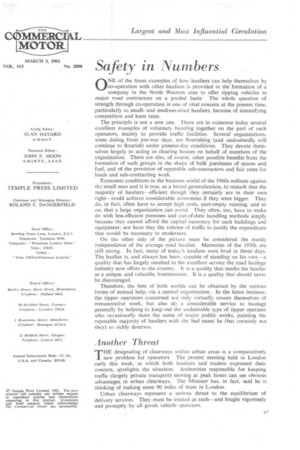Safety in Numbers
Page 35

If you've noticed an error in this article please click here to report it so we can fix it.
ONE of the finest examples of how hauliers can help themselves by co-operation with other hauliers is provided in the formation of a company in the North Western area to offer tipping vehicles to major road contractors on a pooled basis. The whole question of strength through co-operation is one of vital concern at the present time, particularly to smalland medium-sized hauliers, because of intensifying competition and keen rates.
The principle is not a new one. There are in existence today several excellent examples of voluntary banding together on the part of such operators, mainly to provide traffic facilities. Several organizations, some dating from pre-war days, are flourishing (and undoubtedly will continue to flourish) under present-day conditions. They devote themselves largely to acting as clearing houses on behalf of members of the organization. There are also, of course, other possible benefits from the formation of such groups in the shape of bulk purchases of spares and fuel, and of the provision of reputable sub-contractors and fair rates for loads and sub-contracting work.
Economic conditions in the business world of the 1960s militate against thz..,small man and it is true, as a broad generalization, to remark that the majority of hauliers efficient though they certainly are in their own right—could achieve considerable economies if they were bigger. They do, in fact, often have to accept high costs, part-empty running, and so on, that a large organization can avoid. They often, too, have to make do with less-efficient premises and out-of-date handling methods simply because they cannot afford the capital necessary for such buildings and equipment; nor have they the volume of traffic to justify the expenditure that would be necessary to modernize.
On the other side of the picture must be considered the sturdy independence of the average road haulier. Memories of the 1930s are still strong. In fact, many of today's hauliers were bred, in those days. The haulier is, and always has been, capable of standing on his own—a quality that has largely resulted in the excellent service the road haulage industry now offers to the country. It is a quality that marks the haulier as a unique, and valuable, businessman. It is a quality that should never be discouraged.
Therefore, the best of both worlds can be obtained by the various forms of mutual help, via a central organization. In the latest instance, the tipper operators concerned not only virtually ensure themselves of remunerative work, but also do a considerable service to haulage generally by helping to keep out the undesirable type of tipper operator who occasionally mars the scene of major public works, painting the reputable majority of hauliers with the bad name he (but certainly not they) so richly deserves.




































































































































